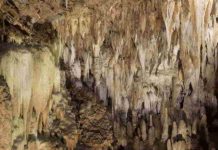
The Earth’s ice ages have left their mark on the thickness of the planet’s oceanic crust, scientists have discovered. During glacial periods, when sea levels are low, the magma that spreads out from mid-ocean ridges to form virgin crust wells up thick and fast. But the production of new crust is stunted in warmer times when sea levels are high, such as they are today.
“We know that volcanism has an effect on climate. What we’re seeing is that climate cycles are also affecting ocean volcanism,” says Richard Katz, a geophysicist at the University of Oxford, UK, and one of the authors of the study, which is reported today in Science.
The researchers say that they have spotted the effect in chains of hillocks under the sea between Australia and the Antarctic. The reason, Katz explains, is that higher sea levels exert a greater pressure on Earth’s mantle below the ocean floor. This seems to slow the transport of molten rock and gas from the mantle up to mid-ocean ridges, where it erupts.
Periodic variations in Earth’s axial tilt and orbit around the Sun have driven the planet’s succession of ice ages and warm periods over the past two million years. During an ice age, more water is trapped on land; as a result, sea levels are more than 100 metres lower than in warm periods. And that can thicken the oceanic crust by around 800 metres (on the order of 10%), Katz says.
Anthropogenic climate change will not impose much extra variation on this pattern. Today’s sea levels are already high, geologically speaking. And scientists will have to hang around for quite a while to spot the effects of modern sea-level rise in the oceanic crust: because magma creeps slowly up from Earth’s interior to the surface, the lag between a change in sea level and the peak crustal thickness response might be about 50,000 years.
A tale of high seas
Scientists knew that changes in the pressure of ice sheets affect what happens in Earth’s upper mantle below land masses. For example, the disappearance of ice is thought to have strongly increased mantle melting and volcanism beneath Iceland. But many geologists were doubtful about whether sea-level variations alone could produce similar effects beneath ridge zones in the deep ocean.
Yet Katz and his colleagues calculated that sea-level variation should sometimes have a discernible effect on the thickness of oceanic crust spreading from ridge zones. The effect is complicated: it depends on the level of the sea, the rate at which this level rises or falls, the rate at which magma upwells from the mantle, and the rate at which oceanic crust spreads sideways from mid-ocean ridges.
The team then backed up its hypothesis by examining two areas of a mid-oceanic ridge between Australia and the Antarctic, which had been surveyed in 2011 and 2013 by the Korean icebreaker Araon. There, the sea floor is lined by elongated chains of hills around 200 metres high. (The change in oceanic crust thickness needed to produce the hills is up to about 800 metres, says Katz; much of the crust is submerged into the mantle, rather as the bulk of a floating iceberg sits under water).
The hills have been formed by a mixture of seismic activity, sedimentation, volcanoes and sea-floor spreading. But the researchers say that in the geological fabric there seems to be a distinct pattern of crustal-thickness variations that are synchronized with 23,000-, 41,000- and 100,000-year glacial cycles known as Milankovitch cycles.
“This is a fascinating discovery and an important key to understanding the creation of oceanic crust,” says Ken Macdonald, a geologist at the University of California, Santa Barbara, who was not involved in the study.
“It’s very convincing, because they actually work through the physics,” says Carl Wunsch, an oceanographer at the Massachusetts Institute of Technology in Cambridge.
A second paper, published today in Geophysical Research Letters, comes to similar conclusions. Maya Tolstoy, a geophysicist at Columbia University in New York, found that volcanic activity along the East Pacific Rise, an ocean ridge off the coast of Mexico, ebbs and flows in regular cycles. Among other shorter cycles, she found on the fast-spreading sea floor in that region a 100,000-year pattern strikingly in synch with the most prominent of Earth’s natural glacial cycles.
Conceivably, examining variations in crust thickness might provide new insights into past glacial cycles and help scientists to better narrow down sea-level change in the deep past, says Wunsch. Meanwhile, a high-resolution topography survey carried out last summer across the Juan de Fuca ridge off the coast of Oregon and Washington offers an opportunity to test the team’s hypothesis further. “We’re going to look at that data very soon,” says Katz.
Reference:
Nature doi:10.1038/nature.2015.16856
Note : The above story is based on materials provided by Nature. The original article was written by Quirin Schiermeier.










